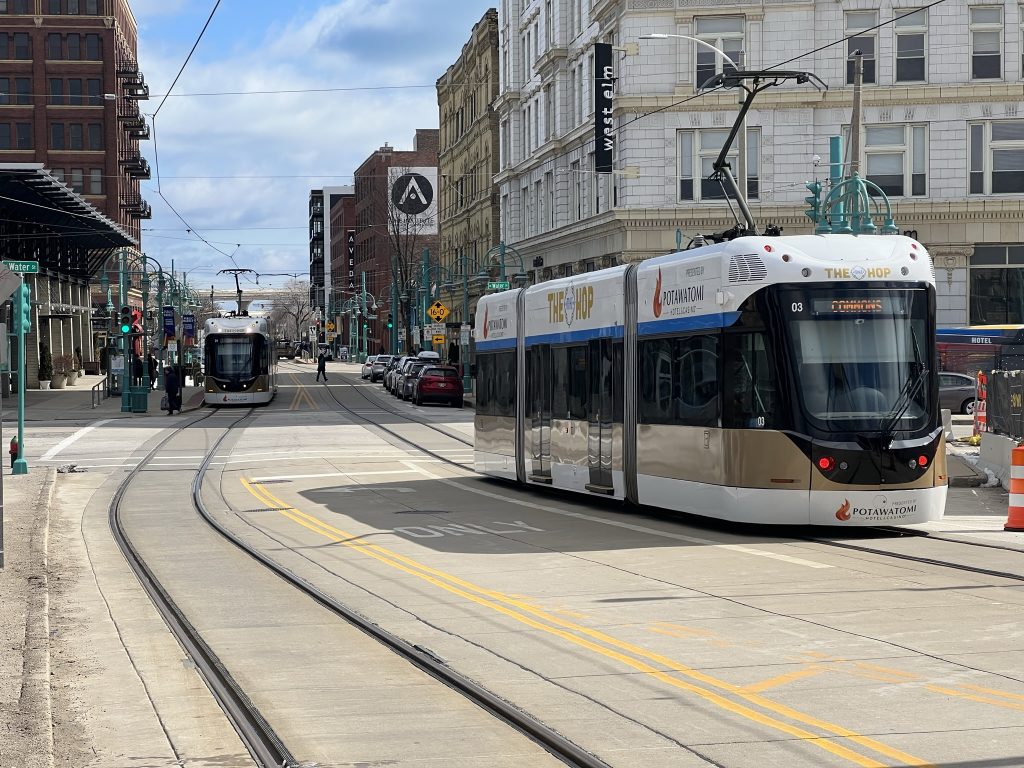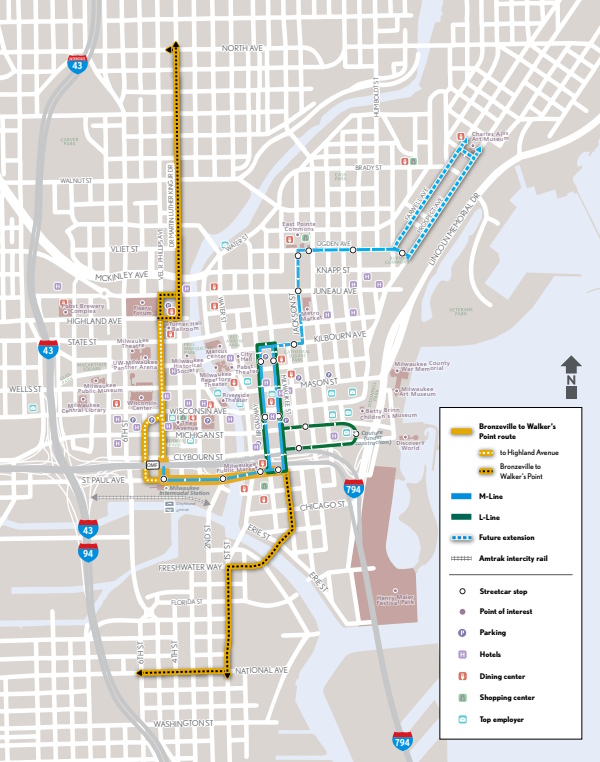Milwaukee’s Three Streetcar Extensions Need Mayoral Direction
Extensions to Fiserv Forum, East Side, Walker's Point and Bronzeville need local funding source.
A proposal to add almost five miles to Milwaukee’s 2.1-mile streetcar system remains stuck at City Hall, despite a July council vote in favor of pursuing federal grants to move forward.
The extensions would run south to the Historic Third Ward and Walker’s Point, north to Fiserv Forum and Bronzeville and northeast to the Lower East Side and Brady Street.
But in order for the federal government to consider a grant request, the city needs to identify a local funding source to fund initial planning and development work. Those costs, much of which would be later reimbursed by the federal government, were pegged at approximately $40 million Wednesday.
Council members and Department of Public Works officials have ideas on options that side step new state prohibitions on using property tax revenue or the city’s sales tax, but Mayor Cavalier Johnson needs to endorse a plan.
“The mayor is our chief executive officer. What’s the vision here to get over this hump?” asked Alderman Robert Bauman at a meeting Wednesday of the Public Works Committee. “Somebody has got to make a decision.”
“From the administration’s perspective, we are continuing to explore our options,” said City Engineer Kevin Muhs at the meeting.
“The Mayor remains committed to expanding The Hop and has directed the Department of Public Works to determine sources of funding that could be used to do so,” said Johnson’s communications director Jeff Fleming after the meeting. “Of all the possible options for local funding, I’m not aware of any that have been excluded. “
A council resolution, endorsed on a 13-2 vote in July alongside adopting a new sales tax, requests the department pursue federal grants and report back on its progress within 90 days.
“There seems to be very strong Common Council support for streetcar expansion,” said Bauman.
Muhs said DPW believes that pursuing federal Small Starts grants from the U.S. Department of Transportation is the appropriate route. He said the city would ultimately submit a different request for each extension, with the program expected to cover 50% to 70% of the capital costs to build the extensions.
How much money would all of the extensions cost? “Roughly in the neighborhood of $400 million and that’s very ballpark obviously,” said Muhs.
To get into the grant program, the city would need to submit an application. “Entering project development is relatively simple,” said Muhs of the program’s first phase and needed to two-to-five page letter.
But that letter has to include a key piece of information the city does not have, “documentation that demonstrates a commitment of funds.”
Bauman, who was openly critical of the City Attorney’s Office multi-month delay in rendering an opinion on whether the new state restrictions were enforceable, pushed for the administration to identify other options and identified at least one of his own.
Muhs said one option is using the Transportation Fund, which is currently used to fund streetcar operations and is filled by the proceeds from parking revenue and tickets. The city annually makes a multi-million transfer to its general fund from the transportation account.
Another option could be raising the vehicle registration fee (wheel tax), which can be used on transportation costs. The city levies a $30 fee currently to pay for local road reconstruction. Milwaukee County has an additional fee that in part funds the Milwaukee County Transit System.
The engineer said the administration would also be interested in any loopholes in Act 12, which added the new prohibitions alongside the sales tax.
A self-taxing neighborhood improvement district (NID) was also given as an option. Similar to a business improvement district, which taxes only commercial properties, a NID would add an additional property tax to parcels in the corridor. A NID is currently used to fund public amenities and programming in The Brewery District and in a handful of other neighborhoods.
Alderman Jonathan Brostoff said a NID would be the most reliable and equitable way to fund the system. A similar framework is used to fund Kansas City’s streetcar system. “It would seem to me that is the most feasible path forward,” said the alderman.
Bauman suggested another option to fund the upfront costs: asking Governor Tony Evers for a share of the state’s American Rescue Plan Act grant. Evers, who has unilateral control of the federal grant, recently announced funding commitments for an Iron District soccer stadium, Bronzeville arts center and other facilities across the state. He’s announced dozen of other allocations, including for affordable housing efforts, reckless driving abatement and business recovery efforts.
The downtown alderman, speaking something assumed for several months, said Evers had also pledged to grant the city $15 to $18 million in ARPA funding to demolish Northridge Mall. “The governor could give us $18 million tomorrow,” said the alderman.
But there isn’t that many tomorrows remaining for that option. ARPA funding needs to be obligated by the end of 2024 and spent by the end of 2026. Bauman pushed Johnson to ask the governor. “This has got to come from the top,” said the alderman. “We need action and vision from the administration.”
There is one pot of money the city has available immediately. There is $250,000, allocated in 2021, in unspent funding in a tax incremental financing district to study a Walker’s Point extension.
Bauman and Brostoff also stressed that the city needs to move faster on seeking the grants.
“My sense is as long as [Joe Biden] remains the president, there is is going to be a strong commitment to infastructure, particularly rail infrastructure,” said Bauman. “If there was ever a time to move, this is the time.”
Past Grant Failures, Shovel Readiness and Possible Timeline
Muhs shared why the city hasn’t had success applying for a smaller grant program, RAISE, to build an extension to the Baird Center and W. Wisconsin Center.
“Basically the feedback from the Biden administration is that basically this project isn’t a good fit for what they want to fund right now,” said Muhs. He said the city would need to successfully win several of the up-to $25 million grants to build a sizable extension.
Through an Obama-era iteration of the program, the city won a grant to build the lakefront extension of system. That extension is now open, but only on Sundays until spring due to delays with The Couture and a need to comply with an already-Congressionally-extended grant deadline.
Muhs said the city believes Small Starts is the appropriate program, especially given its $150 million limit. “That is the program that is used for most transit capital expansion across the country,” he said. That includes the Connect 1 bus rapid transit line and a planned 27th Street bus rapid transit line.
But the program induces delays to align funding commitments with the federal budget. Muhs suggested even if things went as planned, the city likely couldn’t enter federally-sponsored project development until September 2025 and could start construction in 2027.
Some of the extensions, to Fiserv Forum and Brady Street, could proceed faster than the others due to an environmental impact statement being completed alongside the initial system’s development. Muhs said those reports, given their age, would need to be updated, but would expedite work.
The city could also see construction costs fall as the system gets further from Downtown, as there is less utility infrastructure underground. “Downtown is the hub of a lot of different networks,” said Muhs, citing the steam tunnel and communications systems. Bauman was quick to note that the burden of paying for utility relocation was a streetcar-specific burden imposed by the Wisconsin State Legislature after Milwaukee first proposed its system.
Legislation Link - Urban Milwaukee members see direct links to legislation mentioned in this article. Join today
If you think stories like this are important, become a member of Urban Milwaukee and help support real, independent journalism. Plus you get some cool added benefits.
More about the Milwaukee Streetcar
For more project details, including the project timeline, financing, route and possible extensions, see our extensive past coverage.
- FTA Tells Milwaukee to Crack Down on Fare Evasion — Even Where Fares Don’t Exist - Graham Kilmer - Dec 12th, 2025
- Alderman, State Allies Seek Federal Help to Kill the Streetcar - Jeramey Jannene - Oct 28th, 2025
- Streetcar Service Suspended Following Truck Crash - Jeramey Jannene - Oct 21st, 2025
- One Alderman’s Quest To Defund The Streetcar - Jeramey Jannene - Oct 18th, 2025
- Another Streetcar Collision - Jeramey Jannene - Jun 27th, 2025
- Streetcar Hit By Apparent Red Light Runner - Jeramey Jannene - Jun 16th, 2025
- Streetcar Will Run On Consolidated Route During Summerfest - Jeramey Jannene - Jun 11th, 2025
- City Hall: Milwaukee Must Replace Failing Streetcar Switches - Jeramey Jannene - Feb 24th, 2025
- Streetcar Confronts Limited Funding, Operations Challenges - Evan Casey - Jan 22nd, 2025
- Council Kills Streetcar’s ‘Festivals Line’ - Jeramey Jannene - Jul 31st, 2024
Read more about Milwaukee Streetcar here
Political Contributions Tracker
Displaying political contributions between people mentioned in this story. Learn more.
- February 20, 2016 - Cavalier Johnson received $250 from Robert Bauman
Transportation
-
Congestion Pricing Cuts Air Pollution in New York City
 Dec 14th, 2025 by Jeff Wood
Dec 14th, 2025 by Jeff Wood
-
FTA Tells Milwaukee to Crack Down on Fare Evasion — Even Where Fares Don’t Exist
 Dec 12th, 2025 by Graham Kilmer
Dec 12th, 2025 by Graham Kilmer
-
Will GOGO’s Bus Service Ever Get Going?
 Dec 9th, 2025 by Jeramey Jannene
Dec 9th, 2025 by Jeramey Jannene



















How about charging people to ride?